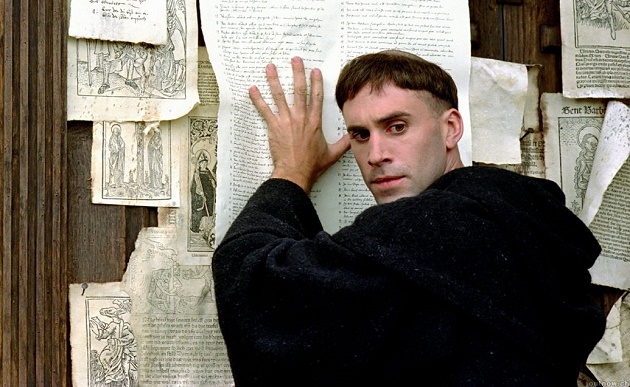 |
| Joseph Fiennes in the Motion Picture Luther 2003 |
Beginning with the Acts of the apostles there has been a constant
struggle from within and without. The time of 1300 AD to 1500 AD is no
exception. During this time the black plague ravaged much of Europe, within the
papacy there was crisis, social and political order outside the church was
changing.
With the papacy in crisis, a Conciliar movement took authority; decreeing
its own authority, and if anyone (including the pope) did not obey the
authority of the council they were to be punished. Such was the case with the
pre-reformer John Hus who was burned at the stake by the council of Constance
for his refusal to obey their demands to recant his writings. John Hus appealed
to the Lord and Judge Jesus Christ and stood on scripture alone.
After the crisis was over (the crisis regarding multiple popes); the pope
disbanded the council and once again regained authority. At this same time a Renaissance
of ancient art and writing was gaining ground in Italy and spreading throughout
Europe. It was the study of scripture in the original languages and reading the
patristics that caused some to question the soteriology and ecclesiology of the
Roman Catholic church. The Renaissance and the Christian faith became linked;
therefore, it was Christian humanist who called for reformation based on
scripture. These Christian humanists believed that it was their knowledge of
Greek and Hebrew that helped them better understand scripture.1
One of those men was Martin Luther; Luther recommended that citizens
receive a classical liberal arts degree and instruction in Hebrew and Greek so
that they could diligently study scripture.2 Martin Luther became a doctor of Theology at the University of Wittenberg.
Through diligent study, while lecturing on the Psalms and Romans, Martin Luther
had a breakthrough. The Catholic Church taught active righteousness through
works, in Romans 1:17 Luther saw that the scripture taught imputed
righteousness through faith in Christ Jesus alone.3
Medieval Catholic doctrine taught a system of planks in salvation. The
first plank baptism, the second plank penance and the third plank purgatory.
Baptism washed away the guilt of original sin, but there was still sin done in
the flesh that must be punished. Penance was required to remove temporal sin.
In 1215 the Fourth Lateran Council defined penance as requiring: contrition,
confession, and satisfaction all done as a responsibility of the sinner.
Contrition is a sorrow for committing sin. Confession is an oral admission of
sin to a priest. Satisfaction required that God be compensated; typically, a
special prayer, fasting, almsgiving, or a pilgrimage. All three most be
completed successfully to receive absolution which is then granted by a priest.
If all three are not done perfectly the sinner most spend time in purgatory to
punish temporal sin.4
While studying this, a question enters my mind; how could anyone believe
this Catholic doctrine, and not live in constant terror of death? It was under
the confines of the sacrament of penance that indulgences were sold, because it
was believed that the pope had the keys to the kingdom, and could give out
merits. Pope Sixtus IV decided that indulgences were good for the sinner in
this life, and good for their family members in purgatory. It was in this
context that John Tetzel sold indulgences using the sales pitch, “Once a coin
into the coffer clings, a soul from purgatory springs.”5 Martin Luther was outraged; therefore, he nailed his 95 Theses to the church
door on October 31, 1517, in Wittenberg, Germany, which became a catalyst for
the protestant reformation.6
1 John D. Woodbridge and Frank A. James, Church History Volume 2: From Pre-Reformation to the Present Day. The
rise and growth of the Church in its cultural, intellectual, and political
context (Grand Rapids, MI:
Zondervan, 2013) 105.
2 Ibid, 101.
3 Ibid, 107-112.
4 Ibid, 112-113.
5 Ibid, 112.
6 Ibid, 112-114.